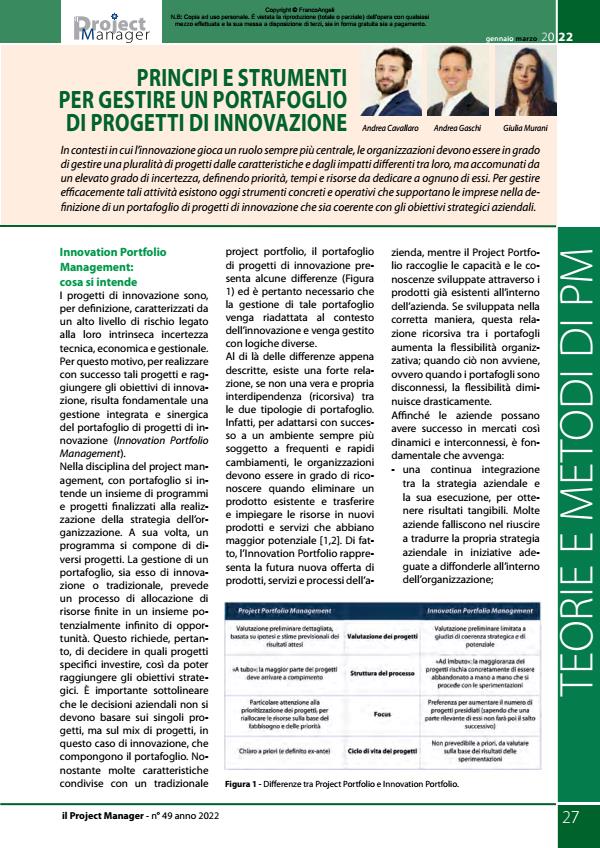Principi e strumenti per gestire un portafoglio di progetti di innovazione
Titolo Rivista PROJECT MANAGER (IL)
Autori/Curatori Andrea Cavallaro, Andrea Gaschi, Giulia Murani
Anno di pubblicazione 2022 Fascicolo 2022/49 Lingua Italiano
Numero pagine 6 P. 27-32 Dimensione file 366 KB
DOI 10.3280/PM2022-049006
Il DOI è il codice a barre della proprietà intellettuale: per saperne di più
clicca qui
Qui sotto puoi vedere in anteprima la prima pagina di questo articolo.
Se questo articolo ti interessa, lo puoi acquistare (e scaricare in formato pdf) seguendo le facili indicazioni per acquistare il download credit. Acquista Download Credits per scaricare questo Articolo in formato PDF

FrancoAngeli è membro della Publishers International Linking Association, Inc (PILA)associazione indipendente e non profit per facilitare (attraverso i servizi tecnologici implementati da CrossRef.org) l’accesso degli studiosi ai contenuti digitali nelle pubblicazioni professionali e scientifiche
- [1] Burgelman R.A. (1994). “Fading memories: A process theory of strategic business exit in dynamic environments”. Administrative Science Quarterly, 39(1), 24–56
- [2] Brasil V.C. & Eggers J.P. (2019). “Product and Innovation Portfolio Management”. Oxford Research Encyclopedia of Business and Management
- [3] McFarthing K., Ohr R.C. (2013). “Managing Innovation Portfolios”. Innovation Management
- [4] Baghai M., Coley S., and White D. (1999). The Alchemy of Growth, New York, Perseus Publishing
- [5] Enduring Ideas: The three horizons of growth. McKinsey Quarterly, 2009. -- https://tinyurl.com/2p9y85sb [ultima visita 20/01/2022]
- [6] Blank S. (2019). McKinsey’s Three Horizons Model Defined Innovation for Years. Here’s Why It No Longer Applies. Harvard Business Review, -- https:// tinyurl.com/bde2n9j5 [ultima visita 20/01/2022]
- [7] Nahji B. & Tuff G. (2012). “Managing Your Innovation Portfolio”. Harvard Business Review, 90(5), 66-74
- [8] Ansoff H. Igor (1957). “Strategies for diversification”. Harvard Business Review, Vol. 35 Issue 5, pp. 113-124
- [9] McGrath R. (2020). Building a Proficiency for Game-Changing Innovation and Growth: Mastering the Opportunity Portfolio. Medium, -- https:// tinyurl.com/hx3tkx9s [ultima visita 20/01/2022]
- [10] Viki T., Toma D., Gons E. (2017). The Corporate Startup: How established companies can develop successful innovation ecosystems
- [11] Toma D. (2016). Portfolio Mapping Framework(s). Medium, -- https:// tinyurl.com/4p3s3bpm [ultima visita 20/01/2022]
- [12] Osterwalder A. & Pigneur Y. (2010). Business model generation: a handbook for visionaries, game changers, and challengers (Vol. 1). John Wiley & Sons
- [13] Osterwalder A. & Pigneur Y. (2017). Business Model Portfolio Part 3: The Business Portfolio Map. Strategyzer, -- https://tinyurl.com/3s55fxfr [ultima visita 20/01/2022]
- [14] Chao R.O. & Kavadias S. (2008). “A theoretical framework for managing the new product development portfolio: When and how to use strategic bucket”. Management Science 54 (5), 907-921
- [15] Cooper R.G. (2013). “Where are all the breakthrough new products? Using portfolio management to boost innovation”. Research Technology Management, Sept-Oct: 25-32
- [16] Kester L., Griffin A., Hultink E.J. & Lauche K. (2011). “Exploring Portfolio Decision-Making Processes”. Journal of Product Innovation Management, 28, 641-661
- [17] Cooper R.G., Edgett S.J. & Kleinschmidt E.J. (1999). “New product portfolio management: Practices and performance”. Journal of Product Innovation Management, 16(4), 333-351
- [18] Kester L., Hultink E.J. & Griffin A. (2014). “An empirical investigation of the antecedents and outcomes of NPD portfolio success”. Journal of Product Innovation Management, 31(6), 1199-1213
Andrea Cavallaro, Andrea Gaschi, Giulia Murani, Principi e strumenti per gestire un portafoglio di progetti di innovazione in "PROJECT MANAGER (IL)" 49/2022, pp 27-32, DOI: 10.3280/PM2022-049006